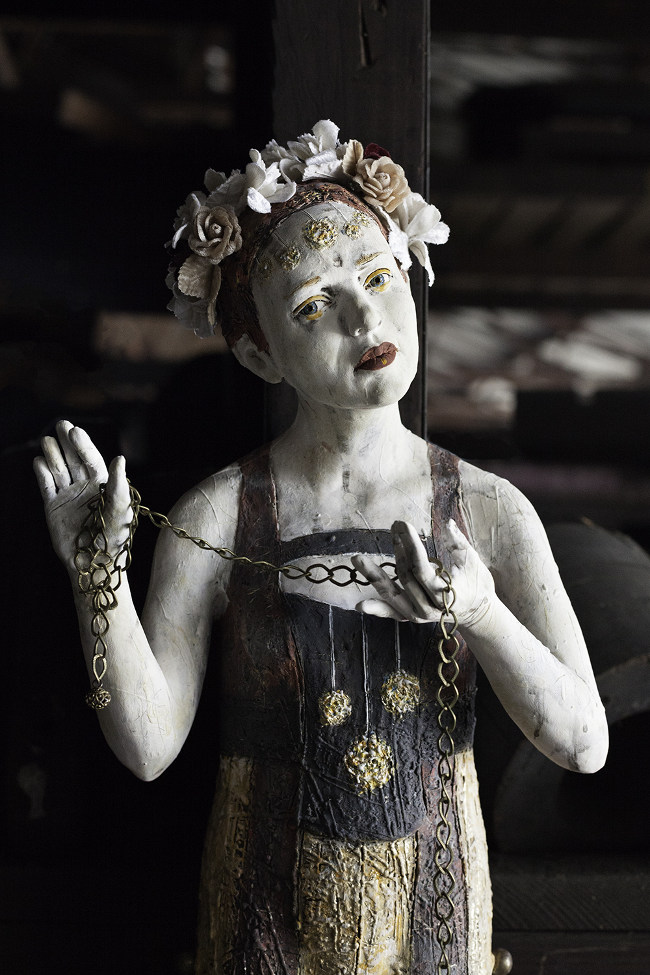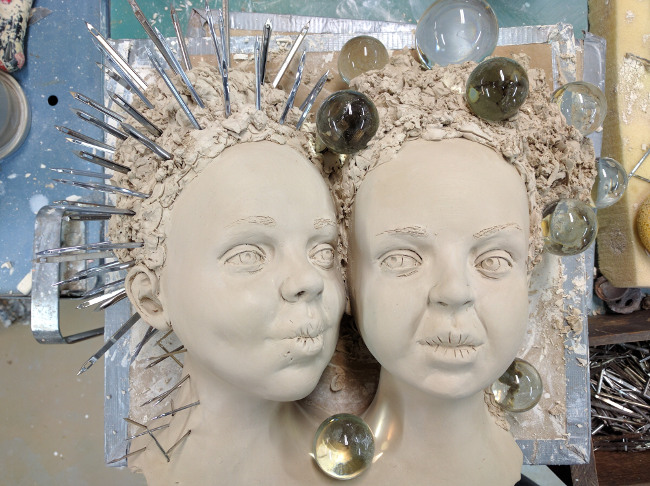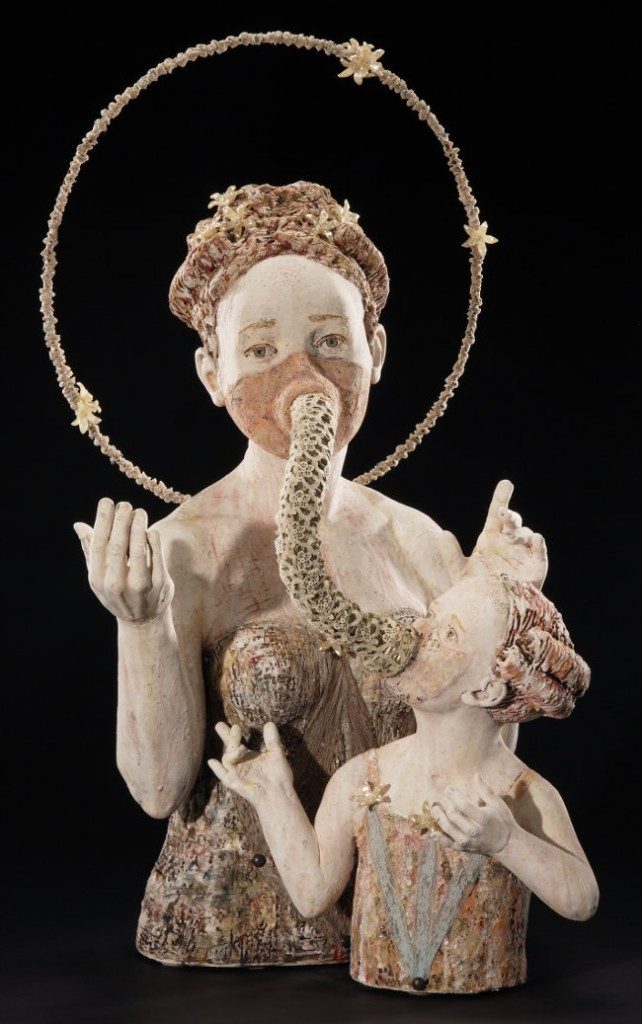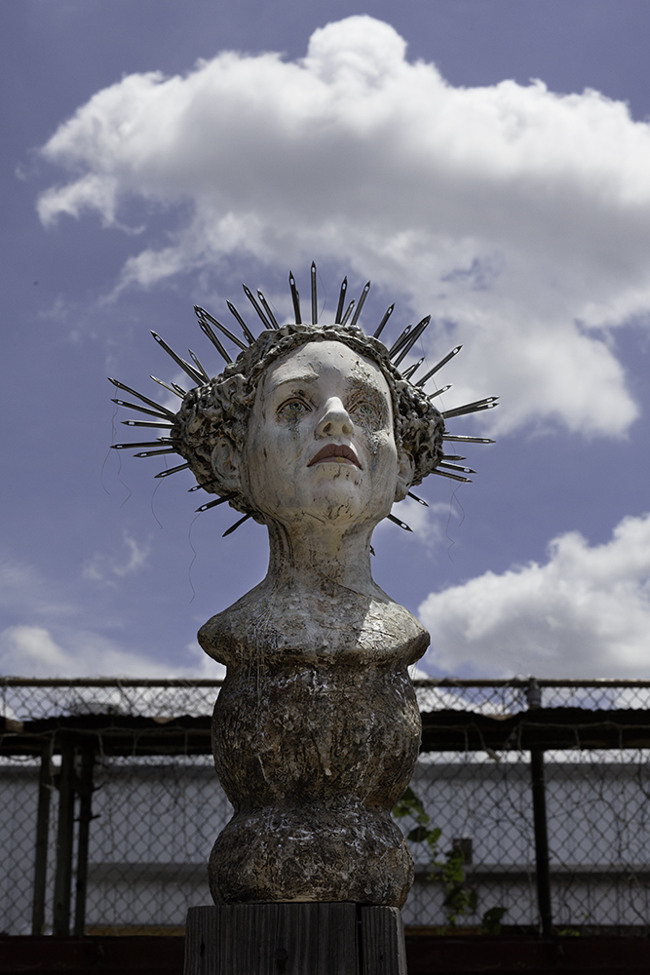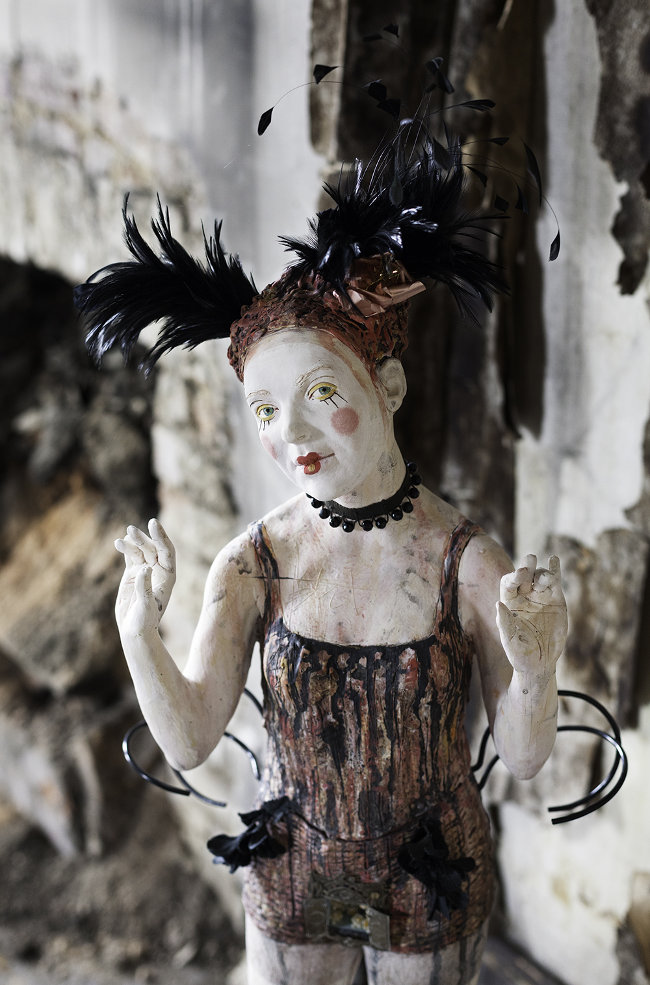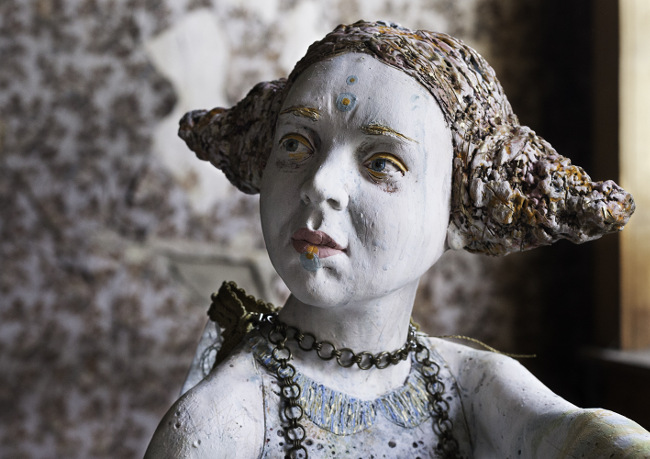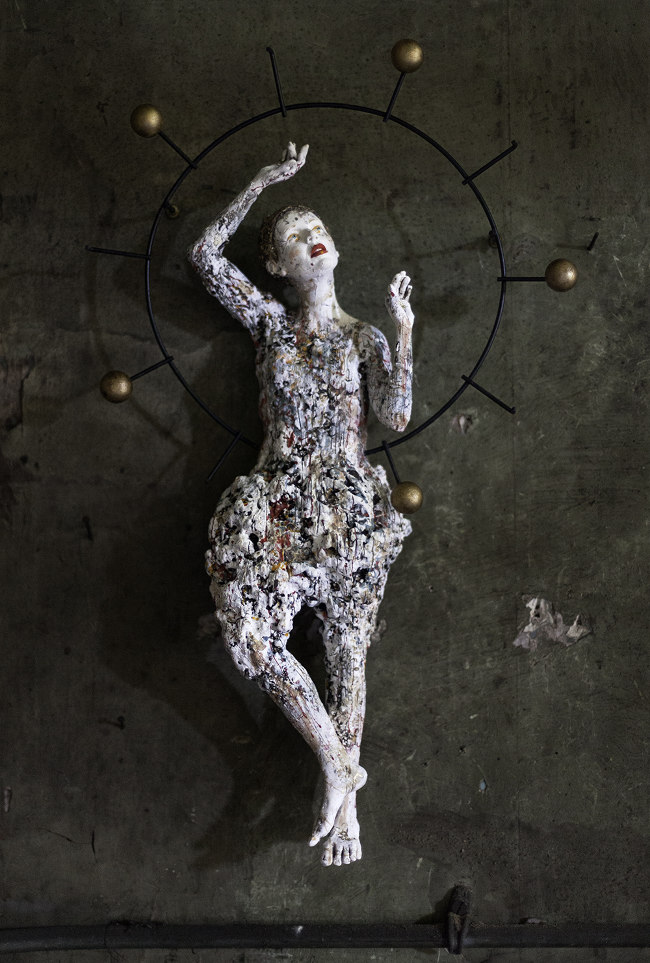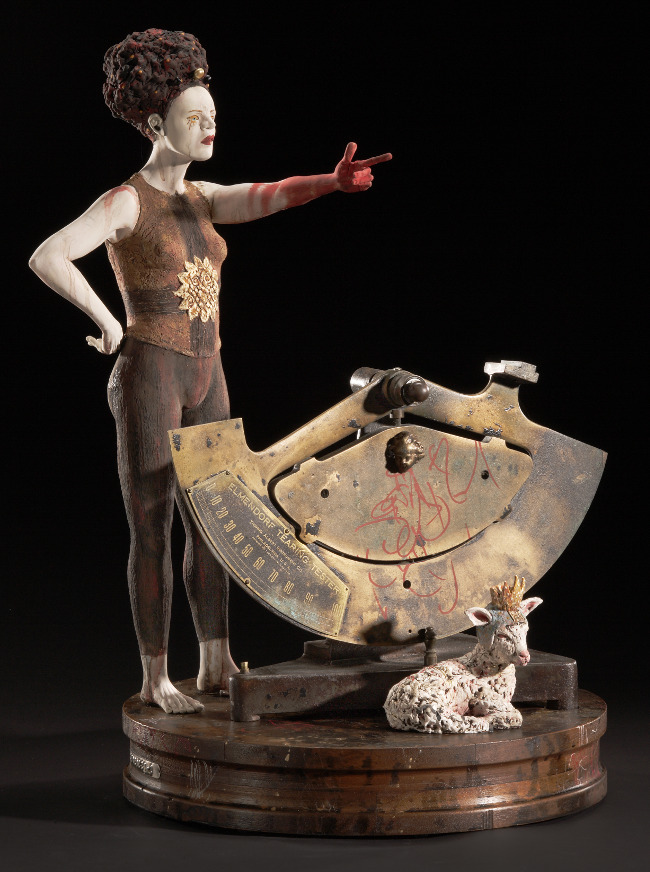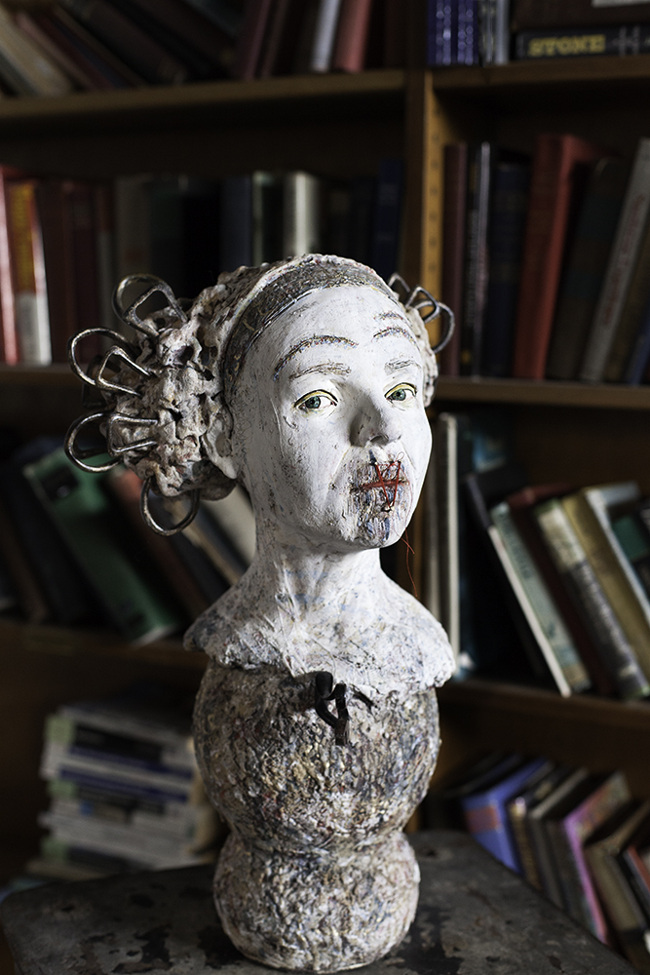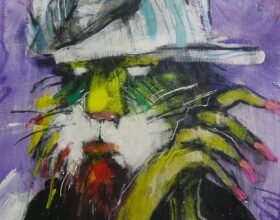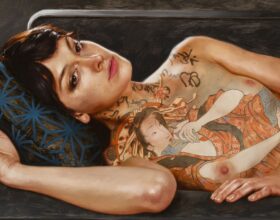Kirsten Stingle: Storyteller, Performer, Philosopher and Sculptress who continuously brings to life innovative and emotive ceramic sculptures that are impossible to forget.
Her journey has been long, evolving throughout her creative journey to bring you a new world of ceramic. With their intricate details and soulful eyes, Kirsten’s sculptures are both captivating and intriguing, and of course her work for the next beautiful.bizarre curated international group exhibition Bitter | Sweet is no exception. Join the beautiful.bizarre team for the opening reception from 6 – 8pm on 18 March 2017 at 19 Karen Contemporary Artspace on the Gold Coast and see Kirsten’s incredibly innovative ceramic sculptures for the very first time in Australia! Read on to find out more about Kirsten’s work for Bitter | Sweet.
Below is an insight into Kirsten’s innermost thoughts, experiences and inspirations.
Your sculptures have been described by Signature Contemporary Craft as confronting a modern paradox of “a wired and globally connected world that creates individual isolation”. Has this concept always been with you or is it something that formed over time?
I have always been attracted to the power of storytelling. Stories help us better understand ourselves, our connection to others, and our place in the world. The best stories do so in a disarming manner that combines humor and beauty with the darkness, [teaching] us to listen but also what it means to be heard. Initially I worked in theatre, helping to create that kind of transformative magic on stage. After 9/11 I began to work in ceramics. Everything seemed so senseless and I felt an overwhelming lack of connection. I started to harness the narrative potential of ceramics for personal reasons: to re-establish my place and connection in this world.
My work cried, “Here is my voice. Will anyone listen?” But as my narrative voice grew, it became less declarative and more about fully exploring the potential of a concept. Pushing and pulling an idea to see it from all sides. From that exploration comes dialogue. From that comes a deeper understanding of our journey.
I’m sure many can still relate to the concept of isolation even (or perhaps, especially) in a time where we can click online and see or speak to someone on the other side of the world in a heartbeat – but it can be a hefty task to translate this through individual sculptures. Can you explain some of your pieces and their representations?
Today we have so many ways to reach out to people from across the globe. We can make friends with people we have never met, instantly share private moments, and voice our opinions for all to hear. But so often, this is surface communication. We may be responding to one another, but we aren’t sharing a dialogue. We aren’t learning new things about ourselves and others.
That opportunity is what I hope to establish with my work. I want to create a dialogue with the viewer, encouraging exploration of the piece and his or her understanding of the human condition. I purposely place my narratives in the “shadows” – the area that combines light and dark with unfolding interpretations. My intent is not to dictate the story to the viewer […] only they can awaken a narrative that uniquely speaks to them. I have learned to only talk in the broadest terms about my work because I don’t want to rob the viewer of his or her story.
I equate it to falling in love with a song. You listen to it over and over because it speaks something very true to what you know. You feel less alone… there is mutual recognition and connection. Then you find out the meaning of the song was actually different – maybe about a pickle the songwriter was eating for lunch. You might continue to like the song, but that personal connection and understanding you felt is forever lost.
That’s not to say that the viewer always will feels comfortable or likes the stories they find in my work. Yet, whether it challenges or deepens their perspective, my work hopefully stirs something in the viewer that brings a closer understanding of themselves and others.
Looking to your upcoming shows, we are really excited to have you on board for ‘Bitter | Sweet’, the international group exhibition at 19 Karen Contemporary Artspace which beautiful.bizarre is curating! With the opening this March 18, 2017, there’s not long to go now…
When Danijela invited me to the show and shared her concept with me, my first thoughts were “PERFECT!!!”. The idea of how seemingly contradictory forces shape our lives is one of the underlying themes in my work. Meaningful stories don’t dwell in the light or the dark, but are a kaleidoscope of colors in between. I always tell people that the real meat of a narrative always lurks in the layers of shadows. So the idea that the value of our existence is made of a tapestry of hopelessly intertwined contradictions is framework I never tire of exploring. Rather than create two completely separate pieces, I wanted to expose their interdependence and the beautiful fragility of their connection captured in a moment.
Did you experience a developmental journey with the theme of ‘Bitter | Sweet’, or rather did you find a concept came to mind straight away?
Initially I was looking at the concept from a personal point of view and how these elements transform with the addition of time and reflection, such as the moment when my children eagerly grasped my hand as we walked; or, the final hugs from a loved one. But in the wake of the current political climate, I began to realize that the bitter/sweet has a much broader scope. It really extends to the very foundations of what we value. It is the fragility of essential concepts, such as respect, justice, love, freedom, friendship, that makes how they are woven into our lives a bitter/sweet experience.
Have you come across any challenges along the way for this exhibition?
I am pursuing a new collection this year and one of the technical challenges I have set for myself is adding glass work into my sculptural narratives. The spectral qualities of glass – delicate, ephemeral and spellbinding – are something I would like to harness in my upcoming work. Bitter | Sweet created the perfect opportunity to seamlessly blend these two mediums, but I had to do a lot of up-front research and experimentation to achieve the desired effect!
If you wish to receive the collectors preview for ‘Bitter | Sweet’ please contact Gallery Director, Terri Lew terri@19karen.com.au
Recently, you undertook quite a feat in designing the collaborative exhibition Sacred and Profane, where your solo works were heightened with the presence of over 20 other visual and performance artists. You described the experience as a “cerebral exercise” to explore what we as humans find sacred and profane, away from the burning tree of religious dogma. Did this project quench the thirst you had to better focus your creativity? Do you think you reached your goal?
Hmm… does anyone ever really believe they achieved their goals? I have the bad habit of never being satisfied with what I’ve done. However, I think I allowed myself to really explore this topic and push and pull it from different angles. I hope I can continue to build on my experiences with collaboration and building larger environments in which the viewer can get lost in a world I create. However, I knew the collection was coming to a close – not because I had said everything there was to say – but because the conceptual umbrella I was working under began to feel restrictive. I grew weary of the constant focus on meaning and intent of each piece to the overarching philosophies I was supposed to be exploring. I had spent over a year with these ideas. It was time to play and dream again.
Did you find any sort of relationships or new thought pathways emerging between yourself/the other artists and your works within this exhibition?
I think the best example of the possibilities and growth within a collaboration is the development of the “The Air We Breathe.” The piece began with building my sculpture of a mother and daughter tethered to a gas mask. I wanted to explore the importance of this relationship and its manifestation of the sacred and profane: the nourishing and toxic possibilities and its reverberations for who we grow to be. However, I soon realized that this idea needed more than just one voice and expanded to an installation. I wanted to recognize the myriad ways women experience and process this relationship. At the time, I was deeply moved by Ann Hamilton’s idea of “being alone, together” and the idea of shared experiences. Therefore, I reached out to more than 20 visual and performing artists, and provided them with three yard fabric strips. These would act as apron strings (an older symbol of the ties between mother and child). Each artist was asked to embellish the strip in any way to represent their personal experience as a mother or a daughter.
What I did not anticipate is the transformative effect this act had many of the artists as they worked on their pieces. Some were forced to deal with issues that they thought were put to rest, while others gained a sense of closure. Some used this as an opportunity to include their aging mothers in the process, creating mutual recognition and gratitude. Other’s voiced their anger at the hurtful echoes that ring in their head. The process informed the powerful intent of the piece provided grounded it in a reality that was full of beauty and pain.
From discussions with one of the apron string artists, fiber artist Gina Pannorfi, developed the idea of a backdrop to the installation. Both of us were discussing the impact of small hand work and embellishment in our apron strings. I found this process slow and out of pace with the tempo of today, but the more time I spent on this “small work” the more I was able to muse on the historical importance and contemporary value. These repetitive and contemplative tasks, allowed space to think and reflect; two things in short supply in contemporary life. From there I introduced more sewing and beadwork to my sculpture, including handmade Victorian bridal lace and beads from my mother’s collection.
Gina took the ideas from this discussion even further by creating four 6 foot panels representing a different stage of womanhood and the idea of what society considers sacred and profane in female development. The panels transformed from delicate, often sheer wool and silk embellished with hundreds of tiny seed beads (largely hidden until revealed by light) into panels that become heavier with pod-like pockets with woven fibers representing the physical and psychological baggage we carry through life.
The Air We Breathe
Pinnacle
Do you think you will do other collaborative shows again?
Absolutely! Collaborating with other artists, both visual and performing, can be challenging because there is a certain loss of control but the process can be so much more meaningful, and the outcome more powerful, than any one voice could produce. The artists I have worked with constantly push my inspirational boundaries and open doors of possibility I’m not sure I would have opened by myself. There is so much to gain when artists share their perspective and talents with one another, not only in terms of personal development but also artistic achievement. It reminds me of my work as a stage manager, working with each artistic vision to create a unified and cohesive whole.
Next time, would you do anything differently?
In the future, I would love the opportunity to work more closely with just one or two artists to build bigger pieces that push us out of our comfort zone. Perhaps spend time working together in each other’s studio to see what develops. I would also like to work on collaborative projects that provide a level of direct community involvement. Perhaps a project that not only provides awareness about social issues but also invites an identified community in its creation and/or production.
I find your artwork can be very easy to connect with. Even with their slightly surreal scenarios, the unapologetic way in which your characters meet our gaze and display subtle poses and hand gestures makes them almost too life-like; it gives a good grounding to create attachments. Do you think your background within the performing arts has had an effect on the way you portray these characters?
Thank you!! Having a background in the performing arts really honed the importance of gesture and expression as storytelling vehicles. And although it is a bit trite to say, the eyes are the windows of the soul. It is thought the eyes that the viewer connects with the work and what it is trying to say. If the eyes don’t invite the viewer in, the piece will never speak, regardless of its intent. Further, I tend to see all of us as just stars of our own dramas “strutting and fretting our hour on the stage.” How comforting to know that we are not alone? Others have experienced the same delusions and indulgences. Moreover, I approach hair and costume as props in the story – the goal being to reveal something about the character rather than hyperrealism.
My constant challenge is to increase my sculpting skills and understanding of anatomy to take full advantage of gesture and natural movement without that becoming the overarching obsession!
Showgirl
Focusing on the act of physically making them, how long on average does it take to make one of your porcelain stoneware pieces?
The actual ceramic building process takes three to six weeks depending on size and complexity. To achieve the ceramic finish usually adds another week. After the pieces are allowed to dry for about a month, they are fired. If possible, I try to only fire once because my building and assembly processes have become longer and more complex. I then spend about two to four weeks on the assembly process with mixed media (welding, carpentry, fabric manipulation, encaustic, painting, etc.) to complete the narrative.
Do you prefer making larger or smaller sculptures?
I love making both – I love all my children equally *laughs*. Seriously, I equate it to stretching different muscles. There is something very freeing about working larger after a series of small, minutely detailed figures. On the other hand, having just had hernia surgery I see the size and weight benefits of working small. Both sizes offer a different narrative potential and demand different mixed media treatment depending. It is much easier for me to create an environment for small figures, employing other objects and materials. On the other hand, for the larger pieces it is much easier to work with the antique fibers I love so much. It’s also easier to create bigger, more detailed statements with the costuming than I can on smaller figures. My goal is to make the mixed media elements as strong and complex as possible but they must not overwhelm the ceramic figure. I try to achieve a sense of seamlessness and balance between all the elements, but this can be different depending on size.
Cape Crusader
Cape Crusader (close up)
Wallflower
Do you have a general process when coming up with new concepts?
Initially I used to use the found object as an inspiration for the sculpture. Now I like working under what I term “conceptual umbrellas” in which I can explore different ideas from all sides. The conceptual umbrellas direct my collection and act as a stable construct for me to explore different themes and to bounce within creatively. For example, one idea I return to often is the idea of self-restraint. I ask, “Why do we hold ourselves back? Is it to provide ourselves a period of rest? Is it the beginning of a metamorphosis? Is it out of fear?” And “how/when do we leave our restraints, and what happens if we never do?” I then transfer these inquiries and the concomitant explorations into my narratives. I never seek a definitive answer or strive to put forward an agenda but, instead, take the approach of a sociologist trying to understand the world around me and our place in it.
In terms of approaching an overarching theme or concept, I usually start by creating a book of images, thoughts, writings, etc. that speak to me. Whether the images or thoughts are discordant with the concept doesn’t come into the equation. It is more a process of thinking about and researching idea, recording all materials that speak to me in some way during that period. This process can last a while – but it’s extremely important as it anchors my work for the collection and is something I can return to for cohesive inspiration. As the narratives start to develop, I then create a storyboard for each piece with images from my notebook and ideas that develop during the clay building process. This storyboard is furthered during the assembly (mixed media) process. Looking at these storyboards, I can trace how I diverged from the original ideas and the development of the narrative.
What I’ve described may seem methodical but that doesn’t mean that there isn’t plenty of room for spontaneity, change, and inspiration. I find this system provides me with a line of continuity between the point I start working on a piece, and the time, months later, when I finish the assembly work. Moreover, not everything I make is created in this process. There are times when I start a piece without a specific story in mind, especially before and after a big collection. Or sometimes a story hits me that I must tell but is outside the scope of the conceptual umbrella. I feel these “untethered” pieces are just as valid as the other works I do.
I know that you enjoy working both under certain constraints and then “breaking the chains” to start something completely different; some would say this allows different aspects of yourself to take control. Have you found your artwork changes depending on the circumstances under which you are creating?
Absolutely! Again, it is that idea of stretching different muscle groups. I never consciously choose the different conceptual umbrellas I work under. Something just takes a hold of my interest –excites me and off I go to explore. But I do spend a lot of time building a foundation for my next journey and letting it lead it wherever it wants to go. That being said, at the end of “Sacred and Profane” I was aware of my desire to work on another part of my artistic vocabulary. It is like an itch. I know it is time to allow the imaginative and surreal, rather than the cerebral, lead me.
Baptism
You utilize a lot of additional mediums into the works like the leather and clasps in ‘Gentle Bindings’ and the delicate interweaving of cotton in ‘Unspoken’. Have you always worked multi-media?
My father’s family grew up on a farm so nothing was ever thrown away that could be re-purposed or reused. When I was a girl, I would spend hours going through his cast-offs to create something else. So it is second nature for me to look at an item and see something completely different. I also feel that the different medias add another dimension to the work, either in terms of the story or just aesthetically. As I stated above, though, the problem is finding the right balance to all the elements. And finding enough time in the studio to fully enhance my mixed-media techniques. I want to make sure that each element is adding to and elevating the art work.
My favourite mixed media to add antique fibers and relics. Vintage materials have always spoken to me. There is a weight of recognition and shared history to older pieces. It might not be our specific history but it contributes to overall story of humanity and helps to explain who we are today. I enjoy using these pieces as narrative vehicles – either twisting their original intent or harnessing their past to further the story and the intent of the work.
Unspoken
Do you have a favourite piece?
All my pieces are my favourite before I build them.
Thank you for taking the time to speak with me Kirsten, it’s been fascinating finding out more about your works! To round things up, can you give us a sneak peek on any of your upcoming exhibits?
I took a year off to build “Sacred and Profane”. My process is incredibly time intensive so it is difficult for me to exhibit and build at the same time. Since the debut of “Sacred and Profane” in October, I have been taking it on the road to different International Art Fairs and gallery exhibitions. This January you can see my collection at Watson-MacRae Gallery in Sanibel, Florida, until February 4th 2017 and at Blue Spiral 1 Gallery in Asheville, NC until March 3rd, 2017. In February I will be debuting my work at Art Palm Springs in Palm Springs, CA from the 16th to the 19th, and beautiful.bizarre-curated Bitter | Sweet from 18 March – 29 April 2017 at 19 Karen Contemporary Artspace. Then, I am off to a residency in Rome, Italy, to start building my new collection.
Standard Bearer
Follow the Leader
Crane’s Song



